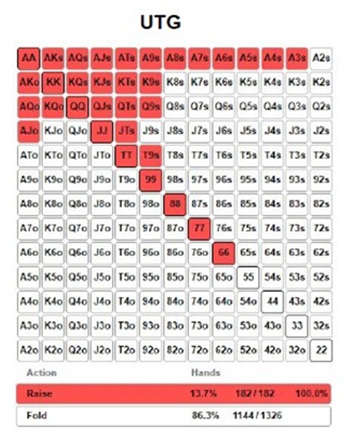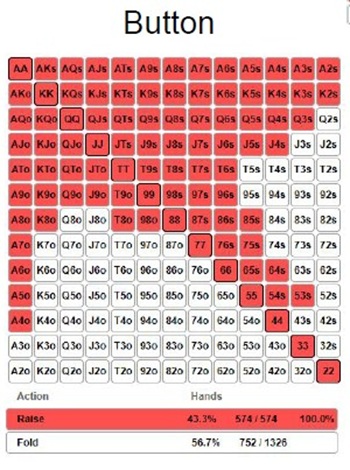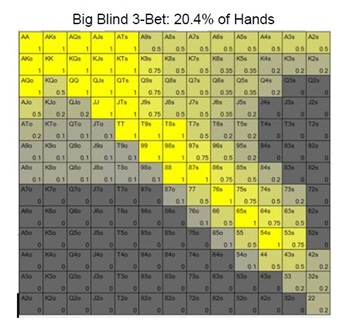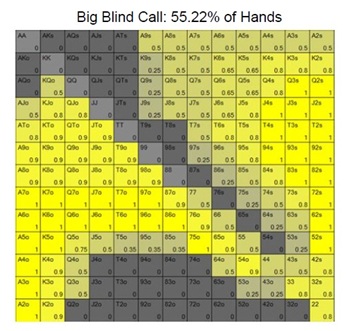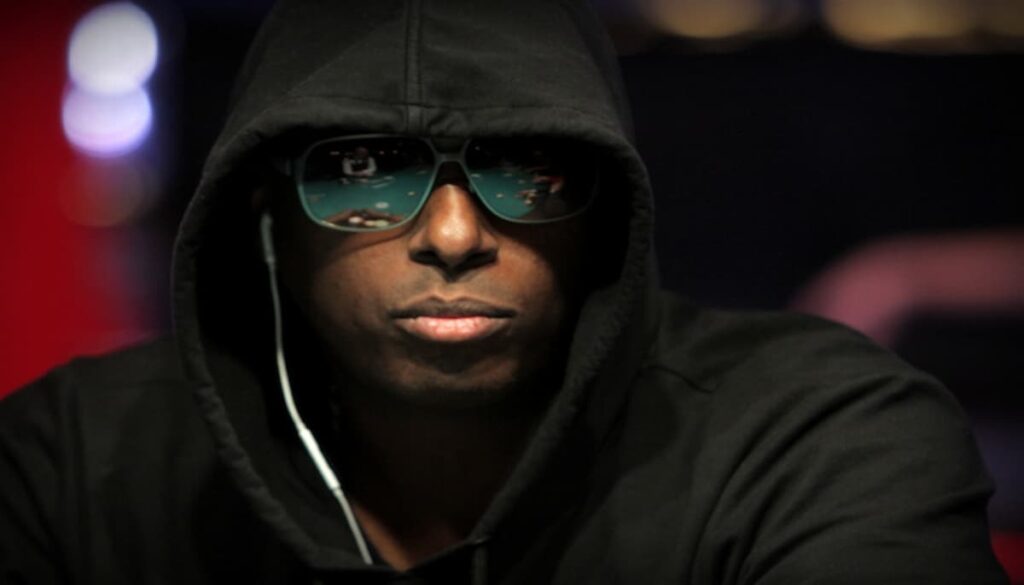Poker strategy isn’t an optional extra. If you want to win in the long run, you need to master the fundamentals and learn everything from basic poker strategy to advanced GTO concepts.
I’ve made just about every mistake you can make. I’ve also absorbed poker tips from the very best. This is my round-up of poker strategy tips for beginners, intermediate, and advanced players.
So, if you want to refine your game, regardless of your current skill level, here are 18 essential online poker tips. Once you’ve digested these, you’ll be ready to play and dominate at all the top US poker sites.

10 Basic Poker Strategy – Tips for Beginners
Newbies these days often want to run before they can walk. Back when I started playing online, people weren’t asking things like, what is GTO poker?
There’s nothing wrong with wanting to know what the true GTO poker meaning is. However, if you want to play GTO poker, you need a solid foundation. Then, you can truly use GTO poker to your advantage and deviate when necessary.
That foundation is made of basic poker strategy advice that’s stood the test of time. Put simply, if you want to become a poker GTO wizard, you need to master the fundamentals. Now that’s clear, here are my top poker tips for beginners.
1. Learn the Rules of Poker
I’m not being facetious, but you need to know the rules of engagement before you go into battle. I recommend to start learning how to play Texas Hold’em because it’s the most popular poker variant and, in many ways, the easiest to understand.
Learn the basics in terms of the antes/blinds, the flow of action, and how hands are ranked. Once you’ve got the basics down, get a feel for how hands play out from start to finish. Use an online poker site’s play money tables to do this without risking your bankroll.
Finally, when you’re comfortable playing Hold’em, learn the rules of other variants, including Omaha and Stud. Learning how to play Omaha Poker and other mixed games will make you a well-rounded poker player.
The knowledge you gain from other games will give you a better appreciation of concepts such as position, value betting, and bluffing. This, in turn, will also make you a better Texas Hold’em player.
2. Tight
The best poker strategy advice I received as a newbie was from Hendon Mob legend and newly-crowned EPT champion Barny Boatman. He said if a hand isn’t good enough to raise, it’s not good enough to play.
Now, I’ll say that you shouldn’t take this advice too literally. There are nuances to all poker tips. However, the point Mr. Boatman was making is that playing tight is never a bad idea. Again, there are spots where you should loosen up.
But, as a general rule, tight is right, particularly when you’re entering pots. Combine this with some selective aggression, and you’ve got a great foundation to build a solid poker strategy.
3. Poker Strategy Chart
In line with my previous point, you need to select the right hands to play. The easiest way to do this is by using a poker strategy chart that tells you which hands are suitable to play from specific positions at the table.
Essentially, the motto here is “start as you mean to go on.” If you start with a strong hand in a strong position, there’s a greater likelihood you’ll be in a strong position post-flop. This doesn’t mean you’ll be unbeatable. However, if you set off on the right foot, things should go smoother than if you start with a weak hand in a weak position.
One thing I’ll say is that you shouldn’t follow a poker strategy chart blindly. They’re a great tool to have in your arsenal, but always consider the suggested move in context. For example, a poker strategy chart might say it’s OK to raise 8♦9♦ from late position if everyone folds.
That’s fine, but what if the player on the button is a maniac and 3-bets often? In this spot, you’re going to lose money over time based on the amount you probably have to fold or take a middle-strength hand to the flop. Therefore, it’s best to use a poker strategy chart in combination with your own reads.
4. Position is King
No discussion on pre-flop poker strategy would be complete without a discussion about poker positions. I’ve mentioned it a few times already, but the power of position can’t be understated. Such is its significance that you can justify playing “weak” hands if you’ve got position on an opponent.
Why? Because you’ve got information and poker is a game of incomplete information. You don’t know which cards an opponent is holding. Therefore, you’re using every other piece of available information to make educated guesses. The more pieces of information you can collect, the more chance you’ve got of making correct reads.
Having position on an opponent means you act after they do. You get to see what they do and react to it. This gives you an extra piece of information they don’t have and, thus, an advantage. That’s why basic poker strategy advocates playing more hands in late position.
The closer you are to the button, the later you get to act in the hand. This gives you more information which, hopefully, allows you to make better decisions. So, if you take nothing from this poker strategy guide, I urge you to think about your position at all times.
5. Aggression
Once you can implement the online poker tips I’ve given you so far, the next thing to think about is how you play the hands you’re dealt. Again, there’s always room for nuance when we’re talking about poker strategy. But, in general, aggression is never a bad thing.
If you’re going to make a play, regardless of whether it’s a value bet or a bluff, do it with a certain amount of aggression. You can do this by betting into an opponent, raising, or re-raising. Being a player that constantly puts pressure on your opponents will make you an absolute nuisance. But if you overdo it, your bluffs are going to get called a whole lot more.
The situation will always dictate the moves you make and you can be aggressive without trashing accepted poker etiquette. But, if you’re going to have a default strategy, it should be to take an aggressive line whenever possible.
6. Start Sizing Up Opponents
I’ve said it multiple times already in this poker strategy guide, but there’s nuance to every situation. This nuance comes from the opponents you’re facing, whether you’re playing live or on one of your favorite poker apps. The way you play a hand against one player could be very different from how you play it against another.
This guide is all about online poker tips for beginners, so I can’t talk about physical tells. What I can give you, however, are some things to take note of when you’re playing online:
- Bet Frequency – Look at how often a player bets or raises. More specifically, look at how often they bet/raise vs. call. A player who calls more than they bet is likely to be weak and passive.
- Bet Sizing – Does a player often bet too little or too much? Consider their bet sizing and note down any times they seem to divert from the norm because this could tell you something about their hand.
- Timing – This is a subtle one, but you can often get a read on players by focusing on the time it takes for them to make a decision. Players who call quickly often have a strong hand or a draw. Players who take an excessively long time to make a bet or raise usually have a monster hand. These aren’t guaranteed reads, but they’re another trait to consider when you’re sizing up opponents.
7. Don’t Get Attached to Starting Hands
Folding hands isn’t illegal. It’s not a sign of weakness, and it’s not always the wrong thing to do. A lot of newbies get attached to their hands. That’s understandable, given that my previous poker strategy tips advocate selecting strong starting hands and playing them aggressively.
However, while I’m all for defending your chips, this doesn’t mean you should dig your heels in and never fold. Even pocket aces can lose, so don’t fall in love with your hands.
8. Bluffing Way Less than You Think You Should
It’s the point in my poker strategy guide that a lot of you have probably been waiting for. Bluffing is the sexiest play in poker when it works, which is why almost every beginner does it far too much.
Yes, bluffing is part of poker, but it’s used less frequently than TV shows would have you believe. I’ll stop short of giving you an ideal bluffing frequency. We’ll talk more about this in the GTO poker strategy section. For now, let’s just say that bluffs should be a small percentage of the plays you make.
9. Game Selection
You might be a great poker player, but winning often comes down to the games you play. Let’s assume you’ve mastered GTO poker strategy and comfortably beat $2/$4 cash games on Bovada. By most standards, you’re a solid poker player who makes money.
Does this mean you can jump into a cash game with Phil Ivey? Absolutely not. If you’re sitting at a table with 8 people better than you, it’s going to be a long night. That’s why you need to find games you can beat.
You do this by looking through the lobby of your chosen online poker site and picking games with attractive stats. The stats you should focus on are the average pot size and flop percentage. If the flop percentage is high, it means people are playing too many pots. Couple this with a high average pot size, and it’s clearly an aggressive game.
If, however, the pot size was low, you could say that people are limping a lot. For me, the latter scenario is better for my style of play. However, you might be different. This is where you need to consider your own preferences and find games that suit you.
10. Bankroll Management
Money matters in poker. Your bankroll is your lifeline, so treat it as such. This means only sitting in games you can afford. The general rule in poker is that you should have at least 20-100 buy-ins for No Limit cash games (more if you’re a beginner). For tournaments, you should have at least 150-300 buy-ins.
So, let’s say you want to play $0.25/$0.50 cash games with a maximum buy-in of $100. You’d need a bankroll of at least $2,000-$5,000. For $5 tournaments, a bankroll of $750-$1,500 or more should help you overcome the swings you’re likely to experience.
This also means that as you win, you should move up stakes. If you lose, you should set your ego aside and move down stakes. Doing this ensures that you’ll never go broke.
What is a bankroll? Your poker bankroll is money you can afford to lose. It’s disposable income and should consist of money you need for daily living expenses.
Intermediate Poker Strategy
Once you’ve mastered the basic poker strategy, it’s time to turn things up a notch. Here are 5 intermediate online poker tips to help you tackle tougher players.
1. Think in Ranges
Beginners often make the mistake of putting opponents on a specific hand. Or, at least, that’s what they try to do. In reality, putting someone on a specific hand is very difficult. That’s why professionals think in ranges.
This means they assign opponents a range of possible hands and gradually whittle it down as they receive new information. For example, based on an opponent’s tendencies, you might put them on the following range: TT+, AJ+, ATs+, KQ, KQs, and a random bluff hand.
As a hand plays out, you remove the bluff from their range. You also remove JJ+. At this point, you need to assess the strength of your hand against the opponent’s possible range and the community cards on display. If there’s a greater chance your hand is beating that range, you call/bet/raise. If not, you can fold.
2. Make Your Story Believable
Poker hands are little stories with a beginning, a middle, and an end. Each part needs to connect with another for the story to make sense. For example, if you limp into a pot, call the flop, and then suddenly try to bluff on the turn by betting, it’s not a believable story.
I’m not saying you can’t mix things up or change the narrative midway through a hand. My point is that you should have an overarching plan at the start of the hand and play in a way that’s consistent with it.
If you want to run a bluff, it’s probably a good idea to be aggressive from the start. If you want to trap someone, be passive until the river. Players who tell the best stories (i.e., take the best lines) often get maximum value from their hands.
3. Choose the Right Bet Size
Bet sizing is important because it helps you get maximum value, lose the minimum, and set up moves on later streets. I can’t take you through the optimum bet sizing for every situation. What I can do, however, is give you some things to consider when you’re counting out bets:
- Consider the size of your bet in relation to the size of the pot. Bets closer to the size of the pot or even overbets give opponents lower pot odds, which can make it harder for them to call with weaker hands or draws.
- Consider the size of your stack. If your bet represents a large percentage of your stack, it signals that you’re committed to the pot and unlikely to fold.
- Consider the size of your opponent’s stack. Betting a large percentage of your opponent’s stack signals that you’re willing to call if they raise/go all-in.
4. What’s Your Image?
Competent novices are great at labeling opponents but less aware of their own image. You’re not invisible at the poker table. Opponents are looking at you as much as you’re looking at them, which is why you need to know your own image.
Let’s say you sit down at a new table and get dealt five premium hands in a row. Because you’re using a pre-flop poker strategy chart, you raise all five hands. None of these hands get to the river, and you claim the pot each time.
At this point, everyone will probably assume you’re a maniac. You know differently, but that doesn’t matter. Your image is now that of a loose, aggressive player. Therefore, you need to take this into account.
Opening with middle-strength hands might be a bad idea for a little while because people are likely to play back at you. That’s what I mean when I say you need to know how other people perceive you.
5. Mix Things Up
In the beginners section, I championed the benefits of playing tight and aggressively. This strategy will always be effective, but there are times when it’s okay to mix things up. In fact, it’s necessary to change your style throughout the course of a game.
I always think it’s best to play tight when you sit at a new table because it gives you a chance to size up other players. However, you can’t play this way the whole time because you’ll be too predictable.
Switching from tight to loose and back again can be highly effective, but you need to do it in the right way. I recommend widening your range in late position. Add in hands such as suited connectors, KT type hands, and some unsuited connectors. Don’t go crazy. Just add in enough hands to make you appear like a loose player.
Advanced Poker Strategy
Before I talk about GTO poker strategy and how it can add another element to your game, let’s discuss some advanced concepts. As a beginner, you might not want to implement these advanced poker tips straight away. However, there’s value in thinking about them as you move up in stakes.
1. Look for Backdoors
This poker strategy concept often gets overlooked by beginners and intermediates, but it can be highly effective when used correctly. The basic premise is simple: bet with backdoor flush draws if you have the lead and position.
Let’s say you’re holding 7♠6♠ and raise pre-flop. One player calls and the flop comes A♦J♣5♠. You’ve missed but shown strength pre-flop. In this spot, it’s worth betting for a few reasons.
Firstly, the flop could hit your range and you’re going to bet most of your range on this flop against late position opponents. Secondly, you have a backdoor flush draw and a backdoor straight draw. This gives you natural opportunities to continue bluffing on any spade, 4, 8, 3, or 9.
In this spot, you’ll have picked up a ton of equity. Therefore, you can continue running a potentially profitable bluff. Alternatively, if you make a flush or a straight on the river, it’s well disguised, and you can likely get paid off.
The point here is that it’s always worth considering what backdoor draws you have because they can allow you to maintain the initiative.
2. Don’t Be Afraid to Raise
It’s easy to raise with the nuts, but what about marginal spots? The very best poker players often find a reason to raise when it seems a call or fold might be better. Perhaps the best example of this from back in the day was Tom ‘Durrrr’ Dwan.
If I recall a story from Phil Galfond correctly, he once asked Dwan whether it was better to call or fold a particular hand on the river. Dwan’s response was: why not raise? That conversation apparently changed the way Galfond viewed spots on the river.
I’m not saying you should raise without a good reason. However, if you figure that your range beats your opponent’s, it could be a good move. Alternatively, if you put an opponent on a marginal hand, raising as a bluff could work.
3. Master Your Mindset
I could give you plenty of advanced online poker tips that delve into the nuances of betting, hand reading, and ranges. However, I think one of the most underappreciated aspects of poker is psychology. Specifically, your own mindset.
Everyone who’s played poker for a while will have gone on tilt. Avoiding this is crucial if you want to win at the highest level. That, of course, is easier said than done, which is why you need to become a master of your own mind.
I recommend reading books such as The Mental Game of Poker by Jared Tendler. I did a lot of work with Tendler during my time at WPT Magazine, and he showed me the traps we all fall into when we’re playing. So, if you really want to become a winning poker player, make sure you master your mindset.
GTO Poker Meaning: What Exactly is GTO?
I’ll give you a basic GTO poker meaning before I go into specifics: GTO poker is based on game theory and aims to create a balanced strategy in all situations.
The crux of game theory optimal (GTO) poker is all possible moves in all scenarios, irrespective of your opponent’s hand. Essentially, with a poker GTO strategy, you’re playing the numbers rather than the player.
The counter to GTO is an exploitative poker strategy where you make moves based on an opponent’s tendencies.
GTO poker strategy virtually removes the need to find holes in an opponent’s game because you’re making mathematically optimal moves that, in the long run, yield a profit regardless of your opponent’s cards.
GTO Poker Charts
How do you achieve balance with a GTO poker strategy? Frequencies, i.e., you need to bet, call, raise, and fold hands a certain amount of time in a given situation. I’ll say two things here:
- Calculating the game theory optimal move for a given scenario is time-consuming, which is why we use solvers and GTO poker charts.
- It’s almost impossible to memorize the GTO move for every possible situation, so the aim is to learn the optimal moves for common situations and work from those anchor points.
As with any poker strategy, GTO plays start before the flop. The GTO poker charts below are from PokerCoaching.com.
I’ve picked out 3 GTO poker charts to give you an idea of what they look like:
Poker Tournament Strategy: First into the Pot Raising Ranges with 75BB Stack from UTG
6-Max Cash Game: First into the Pot Raising Ranges with 100BB stack from Button
Heads-Up: Big Blind 3-Bet and Calling Ranges
Poker Tournament Strategy
The main difference between tournaments and cash games is the continually decreasing blinds-to-stack ratio. The blinds in tournaments increase at set intervals, which means you’re increasingly moving toward a point where deep-stack plays are no longer possible.
Tournament poker strategy accounts for the escalating nature of the blinds. With this in mind, here are 5 quick poker tournament strategy tips to try next time you play:
- Play tight during the early stages of a tournament when the blinds are small.
- Only play hands out of position when it’s absolutely necessary.
- Adopt an all-in or fold mentality when you’ve got under 10 big blinds.
- Be very aggressive against the medium and short stacks when the bubble is approaching.
- Tighten up after the bubble because short stacks will be fighting to get back into the game now they’ve locked up a payout.
Conclusion
Poker, as they say, is easy to learn but difficult to master. That’s why you should see poker as a journey. Start with basic poker strategy and build a solid foundation before you try to build an empire.
Once you’re comfortable with the basics, start adding intermediate and advanced poker strategy concepts to your arsenal. Eventually, with enough study and time at the tables, you’ll become a competent player capable of winning in tougher and tougher games.
